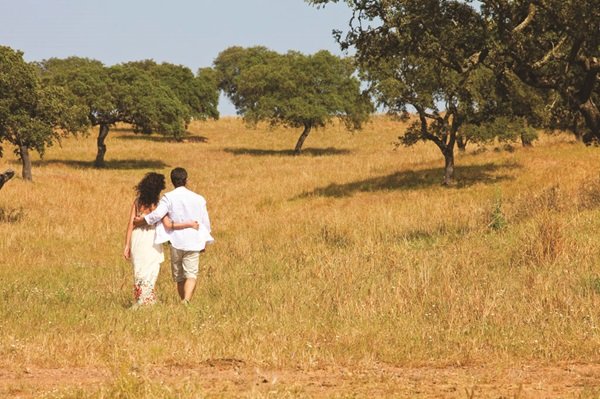Life is tied to nature in the Alentejo, Portugal, where the new tradition of corktrekking can take you on a unique and immersive adventure. As you step into the world of cork forests, cork harvesting, and breathtaking landscapes, you'll see a side of Portugal that is both ecologically significant and culturally rich. On a cork safari, like those offered by Corktrekking in Redondo, the marvels of nature and the allure of cork oak trees come together in perfect harmony. Explore the cork forest on foot, or by SUV and let the spirit of the cork forests embrace you on this extraordinary journey through Alentejo's timeless landscapes.
The cork forests of the Alentejo region in Portugal are a remarkable and ecologically significant natural treasure. Trekking tours in Alentejo offer a rare journey through the region's magnificent cork oak forests, known as "montados." These ancient forests have stood for centuries, offering a haven for biodiversity and supporting the livelihoods of generations of cork harvesters. As you go deep into the green and golden landscapes along winding trails, you'll witness firsthand the sustainable practice of cork harvesting, where skilled cork strippers carefully collect the bark of these majestic cork oak trees without causing them harm.
The montados are not just places of ecological importance; they are repositories of historical wisdom and local skills, as cork products have been a huge part of Portugal's identity for centuries.
During a corktrekking tour, you'll have the opportunity to see up close the natural beauty of cork country, characterized by its rolling hills, golden plains, and diverse flora and fauna. The sound of rustling leaves, the gentle sway of cork oak trees, and the chorus of birds overhead capped by an endless blue sky.
Tour operators such as Corktrekking, are committed to responsible and sustainable tourism. Their tours are designed to minimize the ecological footprint and contribute positively to the conservation of cork oak forests and the communities that depend on them.
The process of harvesting cork from trees requires expert knowledge and precision. Skilled workers, known as corticeiros or "cork strippers," carefully strip the outer bark from the trunk and branches of the trees, leaving the tree itself undamaged. This sustainable harvesting method ensures the longevity of the cork oak trees and their continued role in the ecosystem.
The harvested cork is used in many products, most notably as wine stoppers. However, cork also is used in flooring, insulation, fashion accessories, and even aerospace industries, showcasing its versatility and significance.
The montados
Cork oak trees or Quercus suber, called sobreiros, are native to the Mediterranean basin and thrive in the Alentejo's warm and sunny climate. Cork oaks are often accompanied by their cousins, the Azinheira, or Quercus ilex - whose acorns sustain pigs and sheep. The cork forests create a unique ecosystem, supporting a diverse range of flora and fauna. The forests' biodiversity provides a habitat for numerous plant species, birds, mammals, and insects, contributing to the region's ecological balance and overall health.
Cork trees, the primary species in these montados, possess an amazing feature—their thick and rugged double bark, which sets them apart from other tree species. The cork bark acts as a protective layer against harsh weather conditions, wildfires, and pests. What makes cork oak trees truly remarkable is that their bark can be harvested once a decade without harming the tree, allowing for sustainable cork production. Harvesting actually helps the trees grow, and is only done after the tree is about 30 years old. These cork trees with their immense crowns act as carbon sinks, absorbing and storing carbon dioxide, a major greenhouse gas responsible for climate change. The conservation of cork forests is vital in the fight against global warming and preserving the Alentejo’s environmental balance.
The cork forests and their management are deeply embedded in Portugal's cultural heritage. The traditional practices of cork harvesting, passed down through generations, contribute to the unique identity of the Alentejo region. The cork industry has also shaped local communities and livelihoods, making it an integral part of the cultural fabric of the area.

What to expect
As you arrive at the cork farm in Redondo, you are greeted by the sight of sprawling cork oak trees that dot the landscape at the Herdade da Maroteira. These large canopied trees’ bark are the source of cork.
Your guide will lead you through the farm while sharing the history and significance of cork in the region. You'll learn that cork harvesting is an age-old practice that is carefully regulated to ensure the sustainability of this valuable natural resource. The tour is often in a vintage Land Rover.
As you approach a mature cork oak tree, your guide will explain the careful process of cork bark stripping. The outer bark of the tree is meticulously removed by skilled workers using specialized tools. Don't worry; the process is entirely harmless to the tree, as the bark grows back over time, ready for future harvests.
During the tour of Herdade da Maroteira, you'll gain insight into the incredible versatility of cork. From wine bottle stoppers to flooring materials, insulation, fashion accessories, and even spacecraft components, cork is a sustainable and eco-friendly material that finds its way into various industries.
Immerse yourself in the captivating stories and age-old traditions of cork harvesting with an experienced guide who shares their passion and knowledge about the significance of cork.
A tour of the Herdade da Maroteira in Redondo is an unforgettable journey through the centuries-old tradition of cork harvesting. You'll gain a profound appreciation for the sustainable practices involved in cork production and witness firsthand the expertise of those who work with this versatile material. As you leave the farm, you'll carry with you the knowledge that every cork stopper in your favorite bottle of wine represents a living legacy of Portugal's natural heritage.



